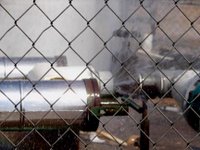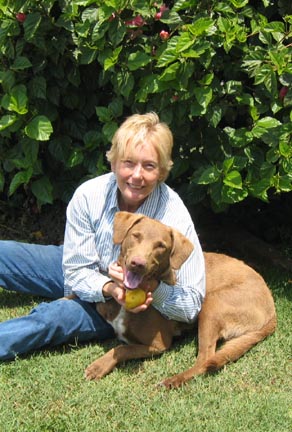Susan's Farm
I farm eighteen acres of lemons in Southern California. It's a rich life that I want to share with you but its future is uncertain. This land will always be green because it is in the middle of the greenbelt between two towns and cannot be developed. But what is its future in agriculture? Will it continue to yield crops whose value is uncertain in global markets or will it become a rich man’s weekend hobby?
Tuesday, July 24, 2007
Floating Overhead

If you’re around here and up early enough on a summer morning, and especially if it’s Saturday or Sunday, you are likely to see hot air balloons floating by overhead. It’s a real surprise to look up and see one. They usually take off just after sunrise when there is little or no wind and are down by 8:30 to 9 before the wind picks up. Hot air balloons float with and in the wind so there is no wind noise when the gas burner is off. That makes it possible to see wild animals that would usually hide. I once tracked a red fox for several hundred yards. Both he and the balloon were moving downwind at the same speed. (No, that wasn’t around here but I bet you’ll see deer and coyotes and no telling what else.) I had my lighter-than-air pilot’s license way back when and I’m still thrilled by it.
Balloon rides over the orchards are part of the agritourism effort to bring more people and, frankly, more dollars into the area. As all of our costs rise and we have to plan for the future when foreign competition begins to hurt the bottom line in earnest, the ag community is finding ways to share the delights of rural life with the general public, for a fee. Within a five-minute drive of my ranch you can take balloon rides, tour a lemon packing house, catch a jeep ride through the back country or have a gourmet meal in the orchard. www.limoneira.com Of course, the oldest form of agritourism around here has got to be the October pumpkin patches, which have grown into major annual events with petting zoos, hayrides and blue grass music. www.underwoodfarmmarket.com And the Christmas tree farms. You can ride a vintage train to a Christmas tree farm, get off, hunt for the best tree, cut it (either by yourself or by a cheerful helper), load it onto a flatbed train car and ride the train back to Fillmore. www.fwry.com Not to mention the weekly farmers’ markets and the strawberry, citrus and avocado festivals. And the county fair that I wrote about last year.
We in
Sunday, March 11, 2007
Beneficials

Spring is an awesome time. There are so many tiny reminders that the world is awakening and starting all over again. Like this lady bug. I came in from the orchard yesterday and out of the corner of my eye saw that something was crawling on my shoulder. Not knowing what it was I batted it off and then discovered that it was a lady bug. I was relieved she wasn’t hurt. I picked her up and watched her as she crawled over my hand and sleeve. What a marvel these little bugs are, red like an m&m with spots. I led her to a lemon tree where she crawled from me to a new leaf.
My Tractor

A few days after Christmas I bought a tractor—a used John Deere 430 with 2,000 hours on it. My friend Bill Milligan said that at 2,000 hours it was just barely broken in. It has a bucket on front and a blade on back. I can finally grade my roads and no telling what kind of jobs I’ll find for it. I’ll need it a lot in the future when I make some changes to the orchard.
(The break peddle is just for slowing it down.)
Sunday, February 04, 2007
I buried a hummingbird this morning. He was lying in the grass near my kitchen door. I picked him up. It was the first time I ever held a hummingbird. He was so light: if I had looked away I wouldn’t have known that anything was in my hand. His iridescent neck feathers shown red violet in patches around his neck. His eyes were an empty grey. He seemed perfect except for two patches of missing feathers on his back. I got the shovel and dug a shallow hole for him and covered him.
Burying former living things is part of life in the country. It happens often. Sometimes a rabbit, sometimes a mole, a mouse, a bird or a butterfly. Sometimes a beloved dog.
I am grateful when I find an intact body because just as often I find parts that must be buried. Very early one morning my Brittany spaniel, Annie, came in her dog door and proudly deposited something on the bedroom carpet. In the predawn light I thought it was a banana peel. When I got up to see what it was I was horrified by a pair of rabbit ears.
Yet there have been times when I have been a rescuer rather than an undertaker. Several years ago I went out the back door and noticed that a hummingbird was feeding low to the ground on the nasturtiums. A few minutes later I walked by again and a loud “beep, beep” caught my attention. The cat was sitting in the middle of the yard. The “beep, beep” came from her. But no, it was coming from the hummingbird in her mouth. I knew if I yelled at the cat she would just run away so I crept very slowly over to her and knelt down beside her. I reached out to her and caught her jaw between my fingers and she opened her mouth. I felt a rush of air. I never saw the hummingbird.
Incredibly the same thing happened again in the same way a few years later.
Wednesday, January 24, 2007
(I wrote this before the freeze.)
Tuesday, January 16, 2007
As I begin to write this the temperature is 25.7, the lowest of the night. It’s 6:30 in the morning. It is usually coldest just before sunrise.
I think the lemon crop for this coming year is lost. It will take a few weeks to actually see the ruined fruit, but there is little doubt that it is gone. Now the question is, for most of my neighbors, whether the trees themselves will survive.
Last Thursday/Friday, January 11/12, was the coldest it has been on the farm. It was 24 degrees for a length of time—I don’t know exactly how long. I’ve been told that two hours at 24 degrees can kill a lemon tree. I know it was under 27 degrees for several hours.
My farm has always been in a quirky position on frost protection. Way back the original ranch was subdivided into three narrow strips a half mile long. My place is the center ranch. As it turned out the existing wind machines were on both sides of us. When we bought the place Ben offered to share the cost of running the machines. Both neighbors refused, probably because they didn’t want the responsibility and the liability that might be involved. The result was that for the past twenty years we have freeloaded on our neighbors. We got to sleep on freezing nights and were spared the expense, which can be considerable. Yet it is a hell of a mess not to have control over something so vital. All I can do is bite my fingernails and hope they run their wind machines.
My area of
This is not a typical year. One of my neighbors hasn’t run his machines this winter. I’ve bit my lip and hoped for the best. While I’m in no position to complain to them I finally just couldn’t stand not knowing why they were ignoring the cold. After it was 24 last Friday morning I got the idea that perhaps one of them was seriously ill—the only plausible reason I could think of for not running the machines. This gave me an excuse to call and ask how they were. They were all fine. I found out that their farm manager had told them that the lower orchard (the part where I could see the wind machines) didn’t get cold enough to need the machines so that was why he wasn’t running them. 24 degrees not cold enough!?
My neighbor on the other side is a flower grower. He has been running his wind machines, which gives me a little protection, except he didn’t run them this morning. I am afraid it means that his crop has already been wiped out. No use in closing the barn door once the horse is out.
So, probably no farm income this year. It kinda takes the fun out of it.
Thursday, September 07, 2006
My Field Boss

I’ve been lucky to have a fine crew of advisors. Tom Mayhew is the field boss for my packing house, Oxnard Lemon. His bother Sam is the manager. They and their late father Wilbur have been a huge help. Tom came by this morning looking for some lemons to pick. He says the price is high and it would pay to have a fall pick. Tom is the one who walks the orchard and tells me when it’s the optimal time to pick. I always trust his judgment. He and Sam are also giving me a lot of good advice about replanting the orchard.
A Typical Irrigaiton

I may have given the impression earlier that all the farm work was done for the year. Not so. Today was irrigation day, which occurs about every four weeks throughout the year unless it happens to rain, which sometimes it does. Doing irrigation means: ordering water, getting water, getting the pump to run, visually checking about seven miles of irrigation hose and sprinklers and repairing or replacing all malfunctioning sprinklers and hoses. Seven miles is no exaggeration—the ranch is almost a half mile deep and there are 14 rows of trees with a sprinkler between every one. 14 rows x .5 mile = 7 miles.

A lot of different things can happen to irrigation hose and sprinklers. Sprinklers get stepped on, run over, stopped up, have snails on them or in them, or they just flat don’t work. And the lines get chewed up by thirsty coyotes. We cure that by putting buckets of water out for them so they’ll leave the lines alone. When we irrigate after a pick we’ve sometimes replaced more than 200 sprinklers that have been stepped on by the pickers. That’s just unavoidable.
Then there are days like today. The pump started perfectly and ran perfectly, something it hasn’t done in years, but that’s another story. But then the piping coming out of the pump started blowing water fifteen feet in the air.



It leaked a little last time we irrigated and I called the pump man to come fix it. There was plenty of time before the next irrigation. But he had problems and it didn’t happen. To get the picture, the pump was putting out 350 gallons of water a minute. That’s a lot of pressure on the pipe. The fix is a major job: to replace the short piece of cracked PVC will require dismantling several connected pieces and taking it all into the shop to duplicate it. This can’t happen on irrigation day. And the dilemma this time is that I irrigate today or a month from today (because I’m exhibiting the prints and maps at a book fair this weekend and then take off to Europe for three weeks). The trees can’t wait. I had to continue the irrigation.
I called the pump man who was working at the other end of the county and couldn’t help. Then Rudy, the waterman who works for Farmers Irrigation, stopped by to take a look. I assured him we had it under control. Then Nick, my neighbor, called to ask what was going on. I reassured him we had it under control.

Matthew and I wrapped the pipe with a tarp so that the water would be directed down and away from the electric pump motor and the electrical box. A huge amount of water ran a quarter of a mile down the orchard to the road. A terrible waste. We continued with the irrigation.
The pump man says he will come tomorrow.
Saturday, September 02, 2006
Raisins--Final Report
I did dry the grapes. I must admit that there was an aroma of fermentation in the kitchen before I got around to it. But when I finally did it was easy and fun. I had enough to cover two and a half cookie sheets, which I put in the oven to dry. I turned on convection heat at 200 degrees for a couple of minutes every few hours and left them for two days. It was going along pretty good until I forgot to turn the oven off. They probably cooked for an hour before I smelled something strange in the kitchen and realized what I had done. Most of the grapes in the tray on the bottom shelf were dried to a carbonized crisp. Fortunately, the top trays were mostly unaffected. However, I lost sight of my goal and dried them too much so they are more than a little chewy. I ended up with about two cups of raisins. They are a bit tart, maybe because I didn’t rinse them after I took them out of their lemon juice antimicrobial bath. But they’re edible. And I will do it again next year. I hope I’ll have enough to share.





